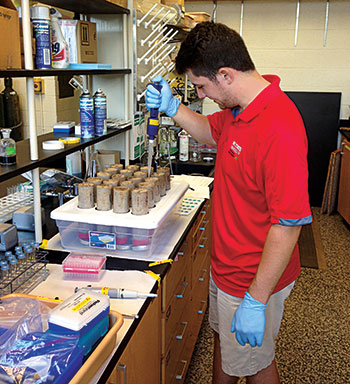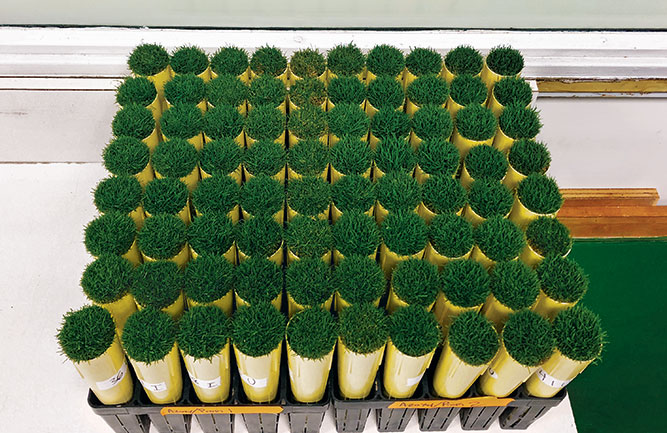Help your fungicide with post-application irrigation
All turfgrass species can be devastated by crown- and root-infecting pathogens. Diseases such as summer patch (Magnaporthiopsis poae), spring dead spot (Ophiosphaerella spp.) and Pythium root rot (Pythium spp.) can decimate turfgrass stands. Cultural management practices are often employed to suppress crown and root diseases such as these, but fungicide applications are necessary to attain optimal control. However, fungicide efficacy has been inconsistent, at best, for various crown and root diseases. Post-application irrigation offers a way to mitigate this inconsistency.
Only one group of fungicides (phosphonates) applied to turfgrass systems is ambimobile, meaning they have the ability to move up and down the plant. Furthermore, the majority of fungicides superintendents apply to turfgrass for crown- and root-infecting pathogens have moderate to high Kd (soil sorption coefficient) and Koc (soil organic carbon coefficient) values, meaning they are readily bound by soil particles and organic matter and are not highly mobile in soil (Table 1).

Application of post-application irrigation with a pipette to soil contained in lysimeters. (Photo: Patrick Maxwell)
These two factors make it difficult for fungicides to reach the crown and root zone where pathogens infect. Therefore, any application method — or other management practices superintendents may employ to move more fungicide to the target sites — likely increases fungicide efficacy. Specifically, post-application irrigation potentially can move more fungicide to the basal and underground portions of the turfgrass plant, thereby increasing efficacy.
Three studies
We conducted two laboratory studies and one growth-chamber study in Raleigh, N.C., in 2017 and 2018 to test the effect of post-application irrigation amounts on fungicide distribution and efficacy. The laboratory experiments examined how post-application irrigation at 0, 0.125, 0.25, 0.5 and 1 inch affected either myclobutanil or tebuconazole distribution in a bare 90 percent/10 percent sand/peat moss soil column (Photo 1). We tagged each fungicide with a 14C-isotope to track its movement through the soil column. We determined the percent 14C-fungicide recovered per depth, and that data is presented below (Figure 1 and Figure 2).

Creeping bentgrass growing in cone-tainers. (Photo: Wendell Hutchins)
We conducted the growth-chamber study with mature Penn A-4 creeping bentgrass (Agrostis stolonifera) grown in cone-tainers (Photo 2). We inoculated the creeping bentgrass with M. poae (summer patch), treated with azoxystrobin (Heritage; Syngenta Crop Protection, Greensboro, N.C., USA) at 0.2 oz./1,000 sq. ft. in a carrier volume of 2 gal/1,000 sq. ft. and immediately irrigated with either 0, 0.1, 0.125, or 0.25 inch of water. We collected turf quality data on a scale from 1-9 (1=dead, 6=acceptable, 9=excellent) throughout the experiment, and plants were destructively sampled to measure root length on the final day of the study (Figure 3 and Figure 4).

Figure 1 Influence of post-application irrigation on 14C-myclobutanil movement. Bars within each sampling depth with the same letter are not significantly different, according to Fisher’s LSD t-test (P < 0.05).
14C-myclobutanil movement study

Figure 2 Influence of post-application irrigation on 14C-tebuconazole movement. Bars within each sampling depth with the same letter are not significantly different, according to Fisher’s LSD t-test (P < 0.05).
In the 14C-myclobutanil study, total recoveries ranged from 81 percent to 112 percent. Regardless of irrigation amount, greater than 51 percent of the 14C-myclobutanil remained in the top inch of soil, and no fungicide was recovered below 4 inches (Figure. 1). However, in the 1-inch to 2-inch depth, we recovered significantly more 14C-myclobutanil when we applied any amount of post-application irrigation compared with no irrigation.
We recovered less than 1 percent 14C-myclobutanil in the 2-inch to 3-inch depth with no irrigation, yet with 0.125 and 0.25 inch of post-application irrigation, there was 2 percent and 3 percent more 14C-myclobutanil recovery, respectively, than no irrigation. The 0.5-inch and 1-inch irrigation treatments yielded the highest 14C-myclobutanil recovery at this depth; however, these irrigation amounts are not feasible immediately after a fungicide application in a field setting. Finally, at the 3-inch to 4-inch depth, we attained the greatest 14C-myclobutanil recoveries with 0.25, 0.5 and 1 inch of post-application irrigation, suggesting that increasing a post-application irrigation amount will increase fungicide distribution.
14C-tebuconazole movement study

Figure 3 Influence of post-application irrigation on azoxystrobin efficacy (average turf quality) against summer patch of creeping bentgrass. Bars with the same letter are not significantly different, according to Fisher’s LSD t-test (P < 0.05).
The trends in the 14C-tebuconazole study were similar to the 14C-myclobutanil study, with greater than 56 percent of 14C-tebuconazole retained in the top 2 inches of soil, regardless of post-application irrigation amount (Figure 2). Also, we recovered no 14C-tebuconazole beyond 5 inches in the soil. The 0-inch to 1-inch depth retained more than 77 percent of the 14C-tebuconazole with both no irrigation and 0.125 inch of post-application irrigation. All other treatments had significantly less 14C-tebuconazole in the top inch of soil. In the 1-inch to 2-inch depth, we recovered at least 9 percent more 14C-tebuconazole with 0.25 inch of post-application irrigation than no irrigation and 0.125 inch of post-application irrigation. The greatest recoveries at this depth were with the 0.5-inch and 1-inch irrigation treatments.
The trend continued in the 2-inch to 3-inch depth, with 1 inch of post-application irrigation moving at least 18 percent more 14C-tebuconazole to this depth than any other treatment. Finally, at both the 3-inch to 4-inch and 4-inch to 5-inch depths, we recovered detectable 14C-tebuconazole only with 1 inch of post-application irrigation.
Azoxystrobin efficacy study

Figure 4 Influence of post-application irrigation on azoxystrobin efficacy (root length) against summer patch of creeping bentgrass. Bars with the same letter are not significantly different, according to Fisher’s LSD t-test (P < 0.05).
In this study, both 0.1 and 0.125 inch of post-application irrigation increased average turf quality by more than 18 percent compared with no post-application irrigation (Figure 3). Furthermore, 0.1 and 0.25 inch of post-application irrigation increased root length by more than 26 percent compared to no post-application irrigation.
Water works
From the data, it’s clear that post-application irrigation increases downward movement of fungicides in soil. Yet, 1 inch of post-application irrigation was not enough to move either 14C-myclobutanil or 14C-tebuconazole beyond 5 inches in the soil, suggesting that fungicide leaching in turfgrass putting greens is highly unlikely because of the high amounts of organic matter (~10 percent v/v) distributed throughout the soil profile. Our data also shows that fungicide efficacy against crown- and root-infecting pathogens is increased with post-application irrigation. This was evident in our last study, with the increased summer patch suppression when we watered in azoxystrobin after application.
Turfgrass managers can employ other management practices to increase fungicide distribution and efficacy against crown and root diseases. These include spraying fungicides at high carrier volumes and regularly applying soil surfactants. We recommend that turfgrass managers targeting crown and root diseases apply fungicides at a carrier volume of at least 2 gal/1,000 sq. ft., tank mix a soil surfactant (include a soil surfactant in the regular spray program if possible) and irrigate with at least 0.25 inch of water immediately (within 30 minutes) after fungicide application.
Wendell Hutchens conducted the research discussed in this article while earning his MS degree at North Carolina State University, and now is a Ph.D. candidate at Virginia Tech University. Travis Gannon, Ph.D., Dave Shew, Ph.D., Khalied Ahmed and Jim Kerns, Ph.D., are at North Carolina State University. You may reach Wendell at wendelljh@vt.edu for more information.
References
Hutchens, W.J., Gannon, T.W., Shew, H.D., and Kerns, J.P. 2019. Effect of post-application irrigation on fungicide movement and efficacy against Magnaporthiopsis poae. Crop Prot. 122:106-111. https://doi.org/10.1016/j.cropro.2019.04.027











